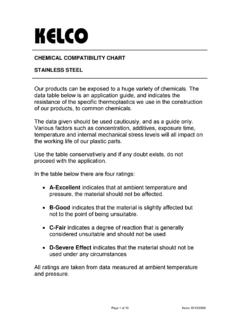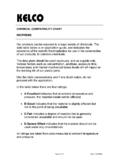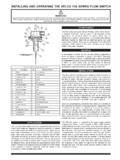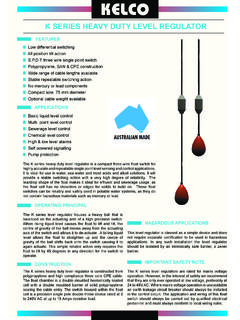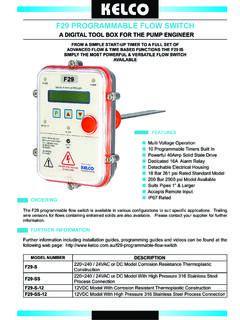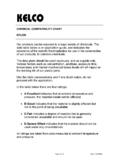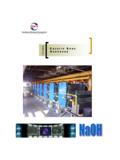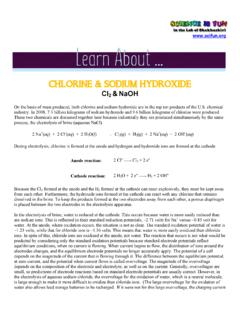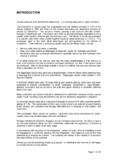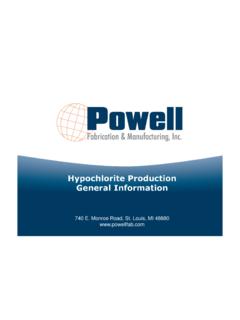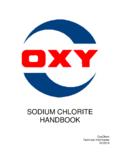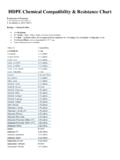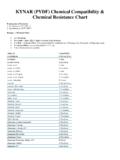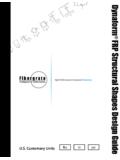Transcription of CHEMICAL COMPATIBILITY CHART HYPALON - …
1 CHEMICAL COMPATIBILITY CHART HYPALON Our products can be exposed to a huge variety of chemicals. The data table below is an application guide, and indicates the resistance of the specific thermoplastics we use in the construction of our products, to common chemicals. The data given should be used cautiously, and as a guide only. Various factors such as concentration, additives, exposure time, temperature and internal mechanical stress levels will all impact on the working life of our plastic parts. Use the table conservatively and if any doubt exists, do not proceed with the application. In the table below there are four ratings: A- Excellent indicates that at ambient temperature and pressure, the material should not be affected. B- Good indicates that the material is slightly affected but not to the point of being unsuitable. C- Fair indicates a degree of reaction that is generally considered unsuitable and should not be used.
2 D- Severe Effect indicates that the material should not be used under any circumstances All ratings are taken from data measured at ambient temperature and pressure. Page 1 of 10 Kelco 15/12/2008 CHEMICALCOMPATIBILITY AcetaldehydeC-Fair AcetamideB-Good Acetate SolventC-Fair Acetic AcidC-Fair Acetic Acid 20%A-Excellent Acetic Acid 80%C-Fair Acetic Acid, GlacialC-Fair Acetic AnhydrideA-Excellent AcetoneC-Fair Acetyl Chloride (dry)D-Severe Effect AcetyleneB-Good AcrylonitrileC-Fair Alcohols:AmylA-Excellent Alcohols:BenzylC-Fair Alcohols:ButylA-Excellent Alcohols:DiacetoneD-Severe Effect Alcohols:EthylA-Excellent Alcohols:HexylB-Good Alcohols:IsobutylA-Excellent Alcohols:IsopropylA-Excellent Alcohols:MethylA-Excellent Alcohols:OctylB-Good Alcohols:PropylA-Excellent Aluminum ChlorideB-Good Aluminum Chloride 20%B-Good Aluminum FluorideA-Excellent Aluminum HydroxideA-Excellent Aluminum NitrateA-Excellent Aluminum Potassium Sulfate 10%A-Excellent Aluminum Potassium Sulfate 100%A-Excellent Aluminum SulfateA-Excellent AminesD-Severe Effect Ammonia 10%D-Severe Effect Ammonia NitrateD-Severe Effect Ammonia, anhydrousD-Severe Effect Ammonia, liquidD-Severe Effect Ammonium ChlorideA-Excellent Ammonium HydroxideA-Excellent Ammonium NitrateA-Excellent Ammonium PersulfateA-Excellent Ammonium Phosphate, DibasicA-Excellent Ammonium Phosphate, MonobasicA-Excellent Ammonium Phosphate, TribasicA-Excellent Ammonium SulfateA-Excellent Ammonium SulfiteA-Excellent Amyl AcetateD-Severe EffectPage 2 of 10 Kelco 15/12/2008 Amyl AlcoholA-Excellent Amyl ChlorideD-Severe Effect AnilineD-Severe Effect Aqua Regia (80% HCl, 20% HNO3)
3 C-Fair Arochlor 1248D-Severe Effect Aromatic HydrocarbonsD-Severe Effect Arsenic AcidA-Excellent AsphaltD-Severe Effect Barium ChlorideA-Excellent Barium CyanideA-Excellent Barium HydroxideA-Excellent Barium SulfateA-Excellent Barium SulfideA-Excellent BeerA-Excellent Beet Sugar LiquidsA-Excellent BenzaldehydeD-Severe Effect BenzeneD-Severe Effect Benzoic AcidD-Severe Effect BenzolD-Severe Effect Benzyl ChlorideD-Severe Effect Bleaching LiquorsA-Excellent Borax (Sodium Borate)A-Excellent Boric AcidA-Excellent BromineD-Severe Effect ButadieneB-Good ButaneB-Good Butanol (Butyl Alcohol)A-Excellent ButterB-Good Butyl PhthalateD-Severe Effect ButylacetateD-Severe Effect ButyleneD-Severe Effect Butyric AcidD-Severe Effect Calcium BisulfiteA-Excellent Calcium CarbonateA-Excellent Calcium ChlorateB-Good Calcium ChlorideA-Excellent Calcium HydroxideA-Excellent Calcium HypochloriteA-Excellent Calcium NitrateA-Excellent Calcium OxideA-Excellent Calcium SulfateA-Excellent CalgonA-Excellent Cane JuiceA-Excellent Carbolic Acid (Phenol)D-Severe Effect Carbon BisulfideD-Severe Effect Carbon Dioxide (dry)B-Good Carbon Dioxide (wet)B-GoodPage 3 of 10 Kelco 15/12/2008 Carbon DisulfideD-Severe Effect Carbon MonoxideC-Fair Carbon TetrachlorideD-Severe Effect Carbon Tetrachloride (dry)D-Severe Effect Carbon Tetrachloride (wet)D-Severe Effect Carbonic AcidC-Fair Chlorine (dry)D-Severe Effect Chlorine WaterC-Fair Chlorine, Anhydrous LiquidC-Fair Chlorobenzene (Mono)
4 D-Severe Effect ChlorobromomethaneD-Severe Effect ChloroformD-Severe Effect Chlorosulfonic AcidD-Severe Effect Chromic Acid 10%C-Fair Chromic Acid 30%C-Fair Chromic Acid 5%B-Good Chromic Acid 50%C-Fair Citric AcidC-Fair Cloroxr (Bleach)B-Good CoffeeA-Excellent Copper ChlorideC-Fair Copper CyanideC-Fair Copper Sulfate >5%C-Fair Copper Sulfate 5%C-Fair CresolsD-Severe Effect Cresylic AcidD-Severe Effect CyclohexaneD-Severe Effect DetergentsB-Good Diacetone AlcoholA-Excellent DichlorobenzeneD-Severe Effect DichloroethaneC-Fair Diesel FuelB-Good Diethyl EtherD-Severe Effect DiethylamineC-Fair Diethylene GlycolC-Fair Dimethyl FormamideD-Severe Effect DiphenylB-Good Diphenyl OxideD-Severe Effect Epsom Salts (Magnesium Sulfate)A-Excellent EthaneB-Good EthanolA-Excellent EthanolamineC-Fair EtherD-Severe Effect Ethyl AcetateD-Severe Effect Ethyl ChlorideD-Severe Effect Ethyl EtherD-Severe Effect Ethylene BromideC-FairPage 4 of 10 Kelco 15/12/2008 Ethylene ChlorideD-Severe Effect Ethylene ChlorohydrinC-Fair Ethylene DiamineB-Good Ethylene DichlorideD-Severe Effect Ethylene GlycolA-Excellent Ethylene OxideD-Severe Effect Fatty AcidsB-Good Ferric ChlorideB-Good Ferric NitrateA-Excellent Ferric SulfateA-Excellent Ferrous ChlorideA-Excellent Ferrous SulfateB-Good Fluoboric AcidA-Excellent Fluosilicic AcidA-Excellent Formaldehyde 100%C-Fair Formaldehyde 40%B-Good Formic AcidA-Excellent Freon 113A-Excellent Freon 12A-Excellent Freon 22B-Good Freon TFA-Excellent Freonr 11B-Good Fruit JuiceB-Good Fuel OilsC-Fair Furan ResinD-Severe Effect FurfuralB-Good Gallic AcidD-Severe Effect Gasoline (high-aromatic)
5 B-Good Gasoline, leaded, Gasoline, unleadedA-Excellent GelatinB-Good GlucoseB-Good Glue, GlycerinA-Excellent Glycolic AcidA-Excellent HeptaneB-Good HexaneB-Good Hydraulic Oil (Petro)A-Excellent Hydraulic Oil (Synthetic)A-Excellent HydrazineB-Good Hydrobromic Acid 100%A-Excellent Hydrobromic Acid 20%A-Excellent Hydrochloric Acid 100%D-Severe Effect Hydrochloric Acid 20%A-Excellent Hydrochloric Acid 37%B-Good Hydrocyanic AcidA-Excellent Hydrofluoric Acid 100%B-GoodPage 5 of 10 Kelco 15/12/2008 Hydrofluoric Acid 20%B-Good Hydrofluoric Acid 50%B-Good Hydrofluoric Acid 75%B-Good Hydrofluosilicic Acid 100%B-Good Hydrofluosilicic Acid 20%B-Good Hydrogen GasA-Excellent Hydrogen Peroxide 10%D-Severe Effect Hydrogen Peroxide 100%D-Severe Effect Hydrogen Peroxide 30%D-Severe Effect Hydrogen Peroxide 50%D-Severe Effect Hydrogen Sulfide (aqua)D-Severe Effect Hydrogen Sulfide (dry)B-Good HydroquinoneD-Severe Effect IodineD-Severe Effect Isopropyl AcetateD-Severe Effect Isopropyl EtherC-Fair Jet Fuel (JP3, JP4, JP5)D-Severe Effect KeroseneD-Severe Effect Lacquer ThinnersD-Severe Effect LacquersD-Severe Effect Lactic AcidA-Excellent LardB-Good Lead AcetateD-Severe Effect Lead SulfamateA-Excellent LigroinC-Fair Linoleic AcidD-Severe Effect LubricantsA-Excellent Lye: Ca(OH)2 Calcium HydroxideA-Excellent Lye: KOH Potassium HydroxideA-Excellent Lye.
6 NaOH Sodium HydroxideA-Excellent Magnesium CarbonateA-Excellent Magnesium ChlorideA-Excellent Magnesium HydroxideA-Excellent Magnesium NitrateA-Excellent Magnesium Sulfate (Epsom Salts)A-Excellent Maleic AcidD-Severe Effect Maleic AnhydrideD-Severe Effect Malic AcidD-Severe Effect Mercuric Chloride (dilute)A-Excellent MercuryA-Excellent MethaneB-Good Methanol (Methyl Alcohol)A-Excellent Methyl AcetateD-Severe Effect Methyl AcrylateD-Severe Effect Methyl Alcohol 10%A-Excellent Methyl BromideD-Severe Effect Methyl Butyl KetoneD-Severe EffectPage 6 of 10 Kelco 15/12/2008 Methyl CellosolveD-Severe Effect Methyl ChlorideD-Severe Effect Methyl Ethyl KetoneD-Severe Effect Methyl Ethyl Ketone PeroxideD-Severe Effect Methyl Isobutyl KetoneD-Severe Effect Methyl Isopropyl KetoneD-Severe Effect Methyl MethacrylateD-Severe Effect MilkA-Excellent Mineral SpiritsC-Fair Monochloroacetic acidA-Excellent MonoethanolamineD-Severe Effect NaphthaD-Severe Effect NaphthaleneD-Severe Effect Nickel ChlorideA-Excellent Nickel NitrateD-Severe Effect Nickel SulfateA-Excellent Nitric Acid (20%)D-Severe Effect Nitric Acid (50%)D-Severe Effect Nitric Acid (5-10%)B-Good Nitric Acid (Concentrated)D-Severe Effect NitrobenzeneD-Severe Effect Oils:AnilineD-Severe Effect Oils:CastorA-Excellent Oils:CoconutC-Fair Oils:Cod LiverB-Good Oils.
7 CornB-Good Oils:CottonseedB-Good Oils:CreosoteD-Severe Effect Oils:Diesel Fuel (20, 30, 40, 50)B-Good Oils:Fuel (1, 2, 3, 5A, 5B, 6)D-Severe Effect Oils:Hydraulic Oil (Petro)A-Excellent Oils:Hydraulic Oil (Synthetic)A-Excellent Oils:LinseedC-Fair Oils:MineralB-Good Oils:OliveB-Good Oils:PeanutB-Good Oils:PineD-Severe Effect Oils:RapeseedD-Severe Effect Oils:SiliconeA-Excellent Oils:SoybeanC-Fair Oils:TurbineD-Severe Effect Oleic AcidC-Fair Oleum 100%D-Severe Effect Oleum 25%D-Severe Effect Oxalic Acid (cold)B-Good OzoneA-Excellent Palmitic AcidD-Severe EffectPage 7 of 10 Kelco 15/12/2008 PentaneB-Good PerchloroethyleneD-Severe Effect PetroleumD-Severe Effect Phenol (10%)D-Severe Effect Phenol (Carbolic Acid)D-Severe Effect Phosphoric Acid (>40%)B-Good Phosphoric Acid (crude)B-Good Phosphoric Acid (S40%)B-Good Phosphorus TrichlorideD-Severe Effect Photographic DeveloperA-Excellent Photographic SolutionsA-Excellent Phthalic AcidA-Excellent Picric AcidB-Good Potassium ChlorideA-Excellent Potassium Cyanide SolutionsA-Excellent Potassium DichromateA-Excellent Potassium FerricyanideA-Excellent Potassium Hydroxide (Caustic Potash)
8 A-Excellent Potassium HypochloriteA-Excellent Potassium IodideA-Excellent Potassium NitrateA-Excellent Potassium SulfateA-Excellent Potassium SulfideB-Good PropyleneD-Severe Effect Propylene GlycolA-Excellent PyridineD-Severe Effect RosinsB-Good RumA-Excellent Salicylic AcidA-Excellent Salt Brine (NaCl saturated)A-Excellent Sea WaterA-Excellent Shellac (Bleached)A-Excellent SiliconeA-Excellent Silver NitrateA-Excellent Soap SolutionsA-Excellent Soda Ash (see Sodium Carbonate)A-Excellent Sodium AluminateA-Excellent Sodium BenzoateB-Good Sodium BicarbonateA-Excellent Sodium BisulfateA-Excellent Sodium BisulfiteA-Excellent Sodium Borate (Borax)A-Excellent Sodium BromideB-Good Sodium CarbonateA-Excellent Sodium ChlorateA-Excellent Sodium ChlorideA-Excellent Sodium ChromateC-FairPage 8 of 10 Kelco 15/12/2008 Sodium CyanideA-Excellent Sodium FerrocyanideB-Good Sodium FluorideB-Good Sodium HydrosulfiteB-Good Sodium Hydroxide (20%)A-Excellent Sodium Hydroxide (50%)A-Excellent Sodium Hydroxide (80%)A-Excellent Sodium Hypochlorite (<20%)A-Excellent Sodium Hypochlorite (100%)B-Good Sodium MetaphosphateB-Good Sodium MetasilicateB-Good Sodium NitrateA-Excellent Sodium PerborateB-Good Sodium PeroxideB-Good Sodium PolyphosphateB-Good Sodium SilicateA-Excellent Sodium SulfateA-Excellent Sodium SulfideA-Excellent Sodium SulfiteA-Excellent Sodium TetraborateA-Excellent Sodium Thiosulfate (hypo)A-Excellent Stannic ChlorideC-Fair Stannous ChlorideA-Excellent StarchA-Excellent Stearic AcidC-Fair StyreneD-Severe Effect Sugar (Liquids)A-Excellent Sulfate (Liquors)B-Good Sulfur DioxideC-Fair Sulfur HexafluorideB-Good Sulfur TrioxideD-Severe Effect Sulfuric Acid (<10%)A-Excellent Sulfuric Acid (10-75%)B-Good Sulfuric Acid (75-100%)C-Fair Sulfuric Acid (cold concentrated)C-Fair Sulfuric Acid (hot concentrated)
9 D-Severe Effect Sulfurous AcidA-Excellent TallowC-Fair Tannic AcidA-Excellent Tanning LiquorsB-Good Tartaric AcidA-Excellent TetrachloroethaneD-Severe Effect TetrachloroethyleneD-Severe Effect TetrahydrofuranD-Severe Effect Tin SaltsA-Excellent Toluene (Toluol)D-Severe Effect TrichloroethaneD-Severe EffectPage 9 of 10 Kelco 15/12/2008 TrichloroethyleneD-Severe Effect TricresylphosphateD-Severe Effect TurpentineD-Severe Effect VarnishD-Severe Effect VinegarA-Excellent Vinyl AcetateA-Excellent Water, DeionizedA-Excellent Whiskey & WinesA-Excellent XyleneD-Severe Effect Zinc ChlorideA-Excellent Zinc SulfateA-ExcellentPage 10 of 10 Kelco 15/12/2008


